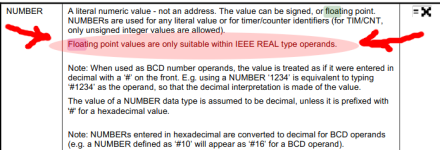Hi!
Newbie here...
Cx-programmer
CP1L PLC
NB7 HMI
I want to multiply something i by 1,5 in CX-Programmer to get a higher number to use in HMI.
Example:
-I have a 4...20mA scaling in a function block that gives me the GRAPH with +0...+1000.
-I want the output in the function block to be multiplied by 1,5 after scaling is done.
-So that when output is ex 500 my sourceword is 750, and when output is 1000 i have sourceword 1500
I might be dumb, but I am in a learning process
Newbie here...
Cx-programmer
CP1L PLC
NB7 HMI
I want to multiply something i by 1,5 in CX-Programmer to get a higher number to use in HMI.
Example:
-I have a 4...20mA scaling in a function block that gives me the GRAPH with +0...+1000.
-I want the output in the function block to be multiplied by 1,5 after scaling is done.
-So that when output is ex 500 my sourceword is 750, and when output is 1000 i have sourceword 1500
I might be dumb, but I am in a learning process







